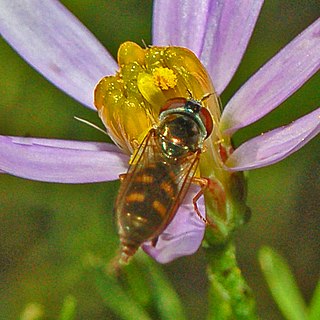
Platycheirus clypeatus is a species of hoverfly. It is found across the Palearctic and in the Nearctic. The larvae feed on aphids. Adults are usually found on the edges of woodland or scrub, heath or along hedgerows where they visit a wide range of flowers.

Eupeodes luniger is a common species of hoverfly.

Platycheirus scambus is a species of hoverfly. It is a Holarctic species.

Platycheirus peltatus is a Palearctic species of hoverfly.

Leucozona laternaria is a European species of hoverfly.

Platycheirus scutatus is a very common species of hoverfly. It is a Holarctic species.

Sericomyia lappona, is a species of hoverfly. It is widespread throughout the Palearctic.

Platycheirus rosarum is a species of hoverfly found in the Palearctic. Like its close relative Platycheirus granditarsus, it can be found in marshy meadows and ditches; indeed, the two species can often be found together. The flight time is between May and October, though it peaks in abundance in June and July.

Pipiza noctiluca is a species of Hoverfly, from the family Syrphidae, in the order Diptera.

Pipizella viduata is a species of Hoverfly, from the family Syrphidae, in the order Diptera.

Parasyrphus vittiger is a species of hoverfly, from the family Syrphidae, in the order Diptera.

Anasimyia lineata is a Palaearctic species of hoverfly.

Trichopsomyia flavitarsis is a European species of hoverfly.

Platycheirus ambiguus is a small widespread species of hoverfly found across the Palearctic from Ireland to Japan. A spring species found in flight in April and May, it visits spring-flowering trees and shrubs, e.g., Prunus spinosa in deciduous woodland and scrub.

Platycheirus angustatus is a species of hoverfly. It is found in many parts of the Palearctic, and in the Nearctic.
Platycheirus perpallidus is a species of hoverfly. It is a Holarctic species.

Eumerus funeralis or lesser bulb fly is a species of Hoverfly, from the family Syrphidae, in the order Diptera. E. funeralis appears in Peck (1988) as a synonym of E. strigatus (Fallen), but was reinstated as the correct name for tuberculatus Rondani, sensu auctorum by Speight et al. (1998).

Lejogaster tarsata is a Palearctic hoverfly

Neoascia obliqua is a Palearctic species of hoverfly.
Cheilosia griseiventris is a Palearctic hoverfly. It is not considered as distinct from Cheilosia latifrons by most European workers. It is variously treated in other and older works.

















